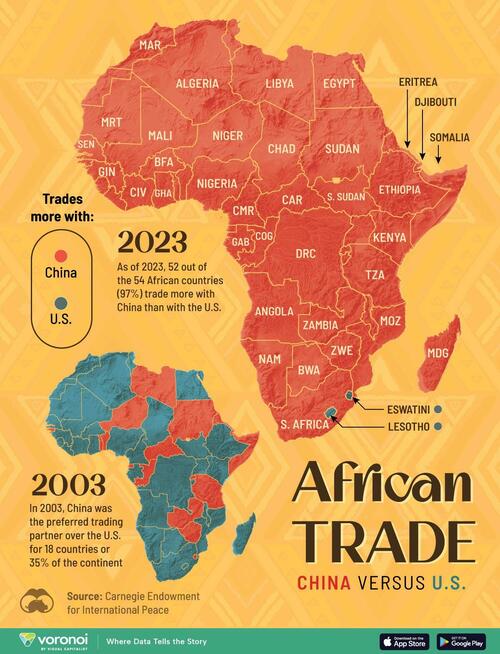China has steadily expanded its global trade footprint and now surpasses the U.S. as the leading trading partner in many regions around the world.
In Africa, for instance, China overtook the U.S. as the continent’s top trading partner back in 2009—a position it continues to hold today.
This graphic, via Visual Capitalist's Kayla Zhu, visualizes whether each African country trades with the U.S. or China more in 2003 versus 2023.
Data comes from the Observatory of Economic Complexity and UN Comtrade via the Carnegie Endowment for International Peace. 2023 or the latest data available was used.
African Countries Are Choosing China over the States
Below, we show which country (U.S. or China) each African country traded with more in 2003 versus 2023.
| Country | Trades more with? (2003) | Trades more with? (2023) |
|---|---|---|
| 🇩🇿 Algeria | 🇺🇸 United States | 🇨🇳 China |
| 🇦🇴 Angola | 🇺🇸 United States | 🇨🇳 China |
| 🇧🇯 Benin | 🇨🇳 China | 🇨🇳 China |
| 🇧🇼 Botswana | 🇺🇸 United States | 🇨🇳 China |
| 🇧🇫 Burkina Faso | 🇺🇸 United States | 🇨🇳 China |
| 🇧🇮 Burundi | 🇺🇸 United States | 🇨🇳 China |
| 🇨🇲 Cameroon | 🇺🇸 United States | 🇨🇳 China |
| 🇨🇻 Cape Verde | 🇺🇸 United States | 🇨🇳 China |
| 🇨🇫 Central African Republic | 🇨🇳 China | 🇨🇳 China |
| 🇹🇩 Chad | 🇺🇸 United States | 🇨🇳 China |
| 🇰🇲 Comoros | 🇺🇸 United States | 🇨🇳 China |
| 🇨🇬 Republic of the Congo | 🇨🇳 China | 🇨🇳 China |
| 🇨🇩 Democratic Republic of the Congo | 🇺🇸 United States | 🇨🇳 China |
| 🇩🇯 Djibouti | 🇨🇳 China | 🇨🇳 China |
| 🇪🇬 Egypt | 🇺🇸 United States | 🇨🇳 China |
| 🇬🇶 Equatorial Guinea | 🇺🇸 United States | 🇨🇳 China |
| 🇪🇷 Eritrea | 🇨🇳 China | 🇨🇳 China |
| 🇸🇿 Eswatini | 🇨🇳 China | 🇺🇸 United States |
| 🇪🇹 Ethiopia | 🇺🇸 United States | 🇨🇳 China |
| 🇬🇦 Gabon | 🇺🇸 United States | 🇨🇳 China |
| 🇬🇲 The Gambia | 🇨🇳 China | 🇨🇳 China |
| 🇬🇭 Ghana | 🇺🇸 United States | 🇨🇳 China |
| 🇬🇳 Guinea | 🇺🇸 United States | 🇨🇳 China |
| 🇬🇼 Guinea-Bissau | 🇨🇳 China | 🇨🇳 China |
| 🇨🇮 Côte d'Ivoire | 🇺🇸 United States | 🇨🇳 China |
| 🇰🇪 Kenya | 🇺🇸 United States | 🇨🇳 China |
| 🇱🇸 Lesotho | 🇺🇸 United States | 🇺🇸 United States |
| 🇱🇷 Liberia | 🇺🇸 United States | 🇨🇳 China |
| 🇱🇾 Libya | 🇨🇳 China | 🇨🇳 China |
| 🇲🇬 Madagascar | 🇺🇸 United States | 🇨🇳 China |
| 🇲🇼 Malawi | 🇺🇸 United States | 🇨🇳 China |
| 🇲🇱 Mali | 🇺🇸 United States | 🇨🇳 China |
| 🇲🇷 Mauritania | 🇺🇸 United States | 🇨🇳 China |
| 🇲🇺 Mauritius | 🇺🇸 United States | 🇨🇳 China |
| 🇲🇦 Morocco | 🇺🇸 United States | 🇨🇳 China |
| 🇲🇿 Mozambique | 🇺🇸 United States | 🇨🇳 China |
| 🇳🇦 Namibia | 🇺🇸 United States | 🇨🇳 China |
| 🇳🇪 Niger | 🇨🇳 China | 🇨🇳 China |
| 🇳🇬 Nigeria | 🇺🇸 United States | 🇨🇳 China |
| 🇷🇼 Rwanda | 🇨🇳 China | 🇨🇳 China |
| 🇸🇹 São Tomé & Príncipe | 🇨🇳 China | 🇨🇳 China |
| 🇸🇳 Senegal | 🇺🇸 United States | 🇨🇳 China |
| 🇸🇨 Seychelles | 🇺🇸 United States | 🇨🇳 China |
| 🇸🇱 Sierra Leone | 🇺🇸 United States | 🇨🇳 China |
| 🇸🇴 Somalia | 🇨🇳 China | 🇨🇳 China |
| 🇿🇦 South Africa | 🇺🇸 United States | 🇨🇳 China |
| 🇸🇸 South Sudan | 🇺🇸 United States | 🇨🇳 China |
| 🇸🇩 Sudan | 🇨🇳 China | 🇨🇳 China |
| 🇹🇿 Tanzania | 🇨🇳 China | 🇨🇳 China |
| 🇹🇬 Togo | 🇨🇳 China | 🇨🇳 China |
| 🇹🇳 Tunisia | 🇺🇸 United States | 🇨🇳 China |
| 🇺🇬 Uganda | 🇺🇸 United States | 🇨🇳 China |
| 🇿🇲 Zambia | 🇨🇳 China | 🇨🇳 China |
| 🇿🇼 Zimbabwe | 🇨🇳 China | 🇨🇳 China |
In 2003, China was the preferred trading partner over the U.S. for 18 African countries or 35% of the continent.
Fast forward 20 years, 52 out of the 54 African countries (97%) trade more with China than with the U.S. as of 2023.
China-Africa trade climbed to $295 billion in 2024, marking a 6% year-on-year increase.
Beyond trade, China has also increased its foreign direct investment (FDI) into the continent, with annual FDI flows rising from about $75 million in 2003 to nearly $4 billion in 2023, focusing on sectors like agriculture, light manufacturing, and services.
China has proactively sought to improve China-Africa relations through major initiatives like the Belt and Road Initiative (BRI) and the Forum on China–Africa Cooperation (FOCAC), which are designed to boost trade by investing in infrastructure, streamlining trade processes, and strengthening African value chains.
However, China has also faced criticism for alleged “debt-trap diplomacy,” a practice in which it is accused of providing loans to countries that may struggle to repay them, including many of Africa’s poorest countries.
To learn more about China’s trade relations, check out this graphic that visualizes the country’s exports by region from 2000 to 2022.
Source link


